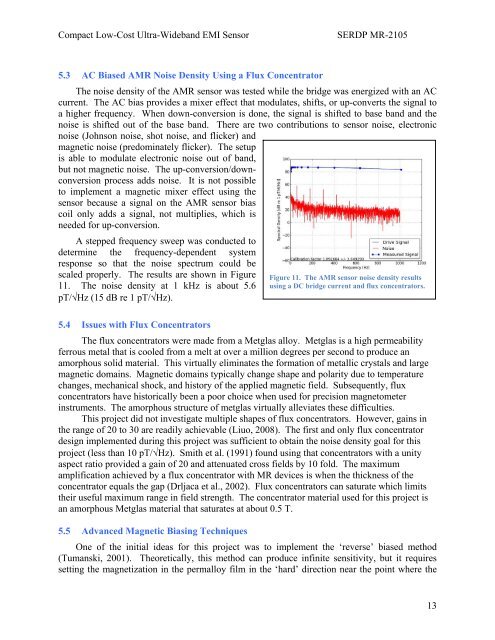Final Report - Strategic Environmental Research and Development ...
Final Report - Strategic Environmental Research and Development ...
Final Report - Strategic Environmental Research and Development ...
Create successful ePaper yourself
Turn your PDF publications into a flip-book with our unique Google optimized e-Paper software.
Compact Low-Cost Ultra-Wideb<strong>and</strong> EMI SensorSERDP MR-21055.3 AC Biased AMR Noise Density Using a Flux ConcentratorThe noise density of the AMR sensor was tested while the bridge was energized with an ACcurrent. The AC bias provides a mixer effect that modulates, shifts, or up-converts the signal toa higher frequency. When down-conversion is done, the signal is shifted to base b<strong>and</strong> <strong>and</strong> thenoise is shifted out of the base b<strong>and</strong>. There are two contributions to sensor noise, electronicnoise (Johnson noise, shot noise, <strong>and</strong> flicker) <strong>and</strong>magnetic noise (predominately flicker). The setupis able to modulate electronic noise out of b<strong>and</strong>,but not magnetic noise. The up-conversion/downconversionprocess adds noise. It is not possibleto implement a magnetic mixer effect using thesensor because a signal on the AMR sensor biascoil only adds a signal, not multiplies, which isneeded for up-conversion.A stepped frequency sweep was conducted todetermine the frequency-dependent systemresponse so that the noise spectrum could bescaled properly. The results are shown in Figure11. The noise density at 1 kHz is about 5.6pT/Hz (15 dB re 1 pT/Hz).Figure 11. The AMR sensor noise density resultsusing a DC bridge current <strong>and</strong> flux concentrators.5.4 Issues with Flux ConcentratorsThe flux concentrators were made from a Metglas alloy. Metglas is a high permeabilityferrous metal that is cooled from a melt at over a million degrees per second to produce anamorphous solid material. This virtually eliminates the formation of metallic crystals <strong>and</strong> largemagnetic domains. Magnetic domains typically change shape <strong>and</strong> polarity due to temperaturechanges, mechanical shock, <strong>and</strong> history of the applied magnetic field. Subsequently, fluxconcentrators have historically been a poor choice when used for precision magnetometerinstruments. The amorphous structure of metglas virtually alleviates these difficulties.This project did not investigate multiple shapes of flux concentrators. However, gains inthe range of 20 to 30 are readily achievable (Liuo, 2008). The first <strong>and</strong> only flux concentratordesign implemented during this project was sufficient to obtain the noise density goal for thisproject (less than 10 pT/Hz). Smith et al. (1991) found using that concentrators with a unityaspect ratio provided a gain of 20 <strong>and</strong> attenuated cross fields by 10 fold. The maximumamplification achieved by a flux concentrator with MR devices is when the thickness of theconcentrator equals the gap (Drljaca et al., 2002). Flux concentrators can saturate which limitstheir useful maximum range in field strength. The concentrator material used for this project isan amorphous Metglas material that saturates at about 0.5 T.5.5 Advanced Magnetic Biasing TechniquesOne of the initial ideas for this project was to implement the ‘reverse’ biased method(Tumanski, 2001). Theoretically, this method can produce infinite sensitivity, but it requiressetting the magnetization in the permalloy film in the ‘hard’ direction near the point where the13
















